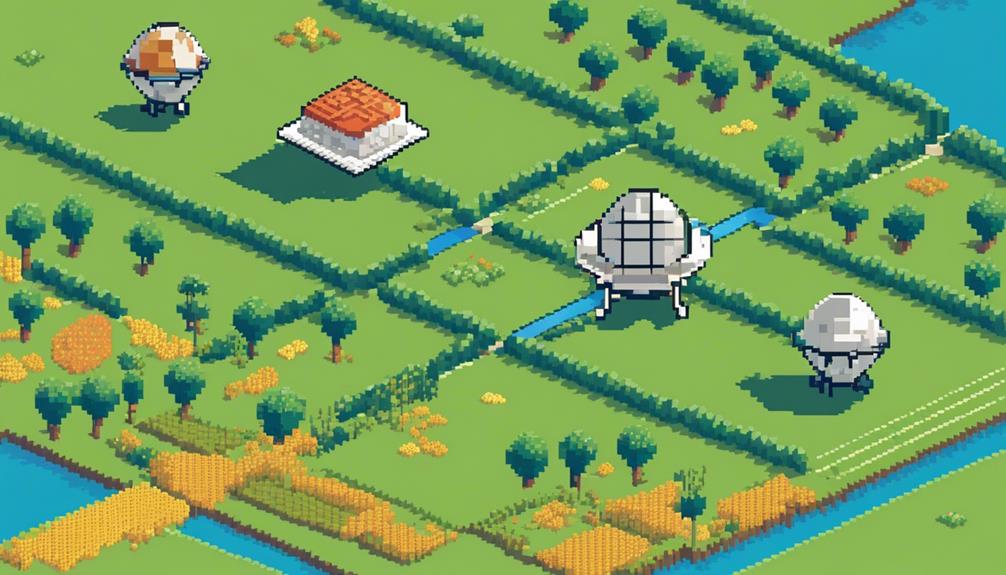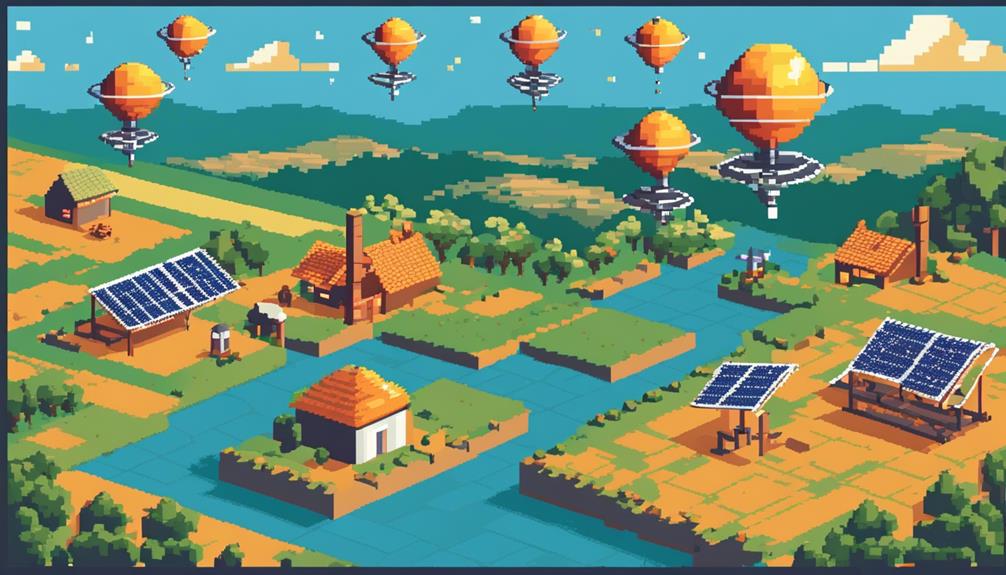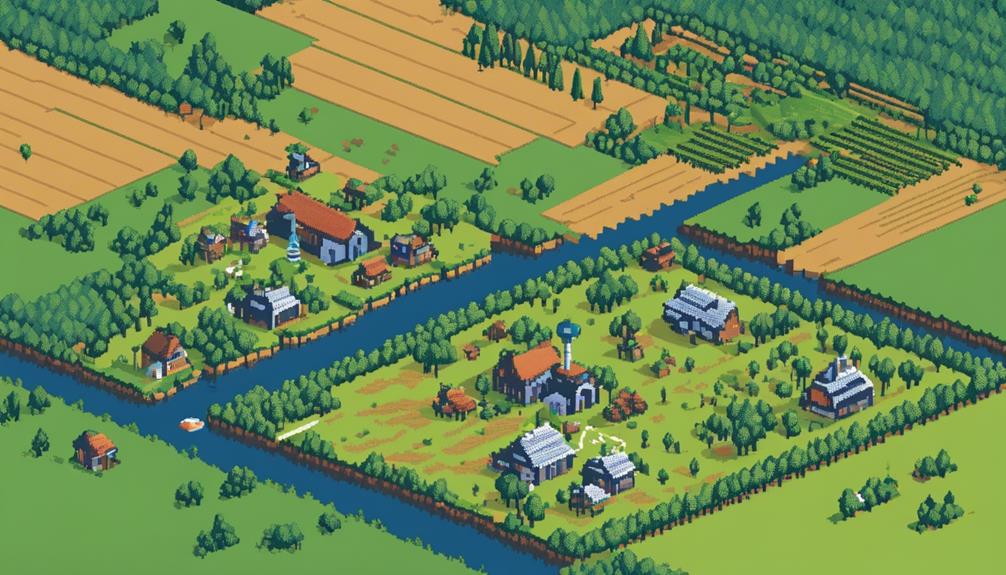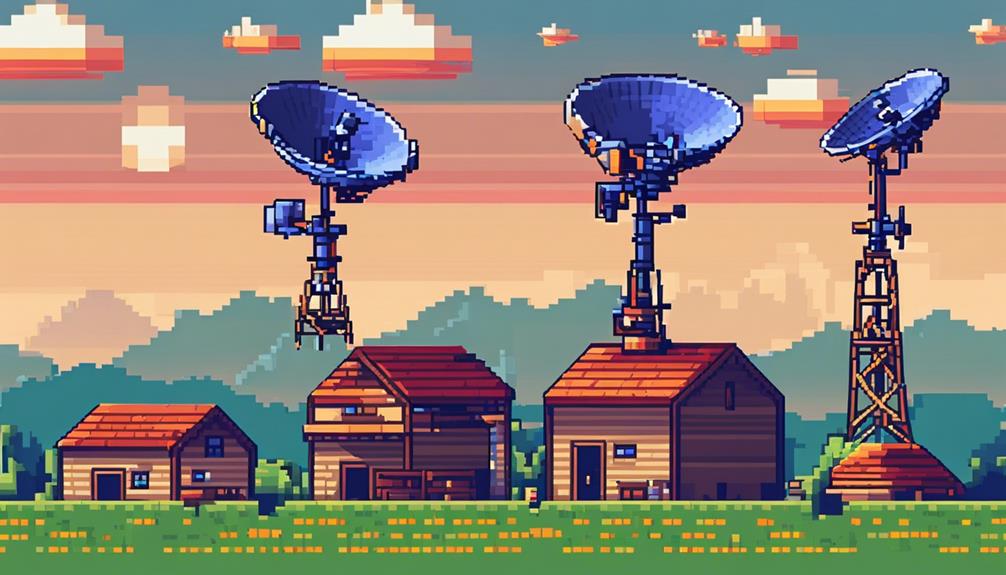The advent of satellite internet competition in rural connectivity is reshaping the digital landscape in underserved regions. With advancements in low-orbiting satellites and fixed wireless solutions, high-speed internet access is becoming more accessible to remote communities. Companies like SpaceX and Amazon are leading the charge, offering speeds that rival traditional broadband services. This competition not only promises enhanced connectivity but also sparks a wave of innovation in bridging the urban-rural digital gap. As satellite internet providers vie for market share, the implications on rural connectivity are profound, hinting at a transformative shift that beckons exploration into the future of rural internet access.
Key Takeaways
- Increased competition among satellite internet providers boosts rural connectivity options.
- Technological innovations drive service quality enhancements and cost-effectiveness in remote areas.
- Rural communities benefit from expanded coverage, improved speeds, and lower prices.
- Market competition fosters advancements, bridging the digital gap for underserved rural populations.
Satellite Internet Providers in Competition

In the landscape of rural connectivity, the emergence of competitive satellite internet providers such as SpaceX's Starlink, Amazon's Project Kuiper, and OneWeb has catalyzed significant advancements in delivering high-speed internet services to underserved areas. These companies are leveraging low-earth orbit satellites to offer improved coverage and connectivity to remote areas. The competition among satellite internet providers is fostering innovation in technology and driving cost-effectiveness in delivering high-speed internet to rural communities.
SpaceX's Starlink, with its ambitious plan to deploy a constellation of satellites in low-earth orbit, aims to revolutionize rural connectivity by providing high-speed internet access to areas where traditional infrastructure is lacking. Amazon's Project Kuiper is another key player in the satellite internet market, focusing on expanding connectivity in remote and rural regions. OneWeb, a global satellite communications company, is also actively investing in satellite internet technology to bridge the digital divide and enhance connectivity in underserved areas.
The competitive environment in the satellite internet sector is fostering advancements that not only improve coverage but also enhance the speeds and affordability of internet services in rural communities. This competition is paving the way for a more connected world, where even the most remote areas can enjoy the benefits of high-speed internet access.
Enhanced Connectivity Solutions for Rural Areas
The advancement of enhanced connectivity solutions for rural areas through low earth orbit satellite services marks a pivotal turning point in bridging the digital gap for underserved communities. The innovative approaches driven by satellite internet competition have significantly improved connectivity options for rural areas, addressing the challenges of remote regions and enhancing overall accessibility. Here are four key aspects highlighting the enhanced connectivity solutions for rural areas:
- High-speed Internet Access: Low earth orbit satellite services such as Starlink and Project Kuiper offer high-speed internet access to previously underserved rural areas, providing a reliable connection for residents.
- Increased Competition Driving Innovation: Competition in the satellite internet market spurs innovation, leading to advancements in coverage, speeds, and affordability. This benefits rural communities by offering them more choices and better services.
- Cost Reduction: The competitive landscape of satellite internet providers works towards cost reduction, making internet services more affordable for rural residents. This cost-effectiveness contributes to bridging the digital divide in underserved areas.
- Rise in Connectivity Options: The presence of multiple satellite internet providers, including Amazon's Project Kuiper, creates a diverse range of connectivity options for rural residents. This variety promotes connectivity and enables more individuals in rural areas to access the Internet seamlessly.
Satellite Internet Competition Benefits

Enhancing rural connectivity through satellite internet competition yields tangible benefits in terms of improved service quality and affordability for consumers in underserved areas. Competition among satellite internet providers, such as SpaceX's Starlink, Amazon's Project Kuiper, and OneWeb, has driven significant advancements in the industry. This competition has not only led to enhanced service quality but has also resulted in more affordable access to high-speed internet in rural regions.
| Benefits | Description |
|---|---|
| Improved Service Quality | Satellite internet competition has spurred technological advancements, leading to faster speeds, enhanced reliability, and better overall service quality. |
| Affordable Access | Increased market competition has resulted in lower prices for consumers in rural areas, making high-speed internet services more affordable and accessible. |
| Expanded Coverage | The presence of multiple satellite internet providers competing for market share has driven infrastructure investments, expanding coverage and connectivity in rural regions. |
| Consumer Benefits | Consumers now have a wider range of choices and service options, benefiting from the competitive landscape in the satellite internet sector. |
Improving Rural Internet Access
Competition among satellite internet providers such as SpaceX's Starlink and Amazon's Project Kuiper is instrumental in advancing connectivity solutions for rural areas, particularly in enhancing internet access and bridging the digital divide in underserved communities. This competition is driving innovation and leading to significant improvements in rural internet access. Here are four ways in which satellite internet competition is enhancing connectivity in remote regions:
- Expanded Coverage: Companies like SpaceX and Amazon are expanding high-speed internet access to previously underserved rural areas, offering connectivity where traditional terrestrial internet options are limited.
- Lower Costs: Increased competition in the satellite internet market is resulting in lower costs for consumers in rural areas, making high-speed internet more affordable and accessible to a broader population.
- Improved Service Options: Rural residents now have access to a variety of service options from different satellite internet providers, allowing them to choose plans that best suit their needs and budget.
- Bridging the Digital Divide: The enhanced connectivity and improved internet speeds brought about by satellite internet competition are helping bridge the digital divide in underserved areas, ensuring that rural communities are not left behind in the digital age.
Competition Driving Innovation in Connectivity

The fierce competition between satellite internet providers in the rural connectivity sector is catalyzing technological advancements, resulting in innovative solutions tailored for remote areas. This competitive landscape is propelling the industry towards delivering faster, more reliable internet services to underserved regions, ultimately expanding connectivity options for rural residents. The drive for innovation fueled by market rivalry is leading to enhanced connectivity offerings, benefiting rural communities through improved coverage and more cost-effective solutions.
Innovation in Rural Areas
Innovative advancements in satellite internet technology are catalyzing a transformative shift in rural connectivity solutions. Competition among satellite internet providers is pushing the boundaries of innovation to address the connectivity challenges faced by rural areas. Here are some key points illustrating the impact of this innovation:
- Advanced Satellite Technology: Companies like SpaceX's Starlink and Amazon's Project Kuiper are investing in cutting-edge satellite technology to expand coverage and boost internet speeds in underserved rural regions.
- Affordable Pricing Plans: The competitive landscape is driving providers to offer more affordable pricing options, making high-speed internet more accessible to rural customers.
- Enhanced Customer Service: To attract and retain rural subscribers, there is a focus on improving customer service standards to ensure a seamless user experience.
- Reliable Systems: Innovation in satellite internet technology is leading to the development of more reliable and efficient systems tailored to meet the needs of rural communities.
Benefits of Competition
The proliferation of satellite internet providers in rural connectivity markets drives the evolution of innovative solutions tailored to meet the growing demand for reliable high-speed internet access. Competition among satellite internet providers spurs innovation in connectivity solutions for rural areas, pushing for improvements in speeds, reliability, and coverage in underserved regions. This competitive environment also results in more affordable pricing plans and enhanced service options for rural residents. Companies such as SpaceX, Amazon, and OneWeb engage in fierce rivalry, leading to technological advancements that benefit rural internet access. The competitive landscape facilitates the rapid deployment of high-speed satellite internet infrastructure, ultimately empowering rural communities with better connectivity options.
Improved Connectivity Options
Competition among leading satellite internet providers is propelling advancements in connectivity solutions tailored to meet the increasing demands for high-speed internet access in rural areas, fostering innovation and driving the evolution of improved connectivity options. This competitive landscape is reshaping the connectivity market by introducing groundbreaking technologies and expanding coverage to previously underserved communities. The focus on innovation driven by competition is resulting in enhanced high-speed connectivity offerings, making it more affordable and reliable for rural residents. With the emergence of new players in the low earth orbit internet sector, such as OneWeb, the options for rural connectivity are diversifying, pushing existing providers to elevate their services to remain competitive and ensure improved coverage and performance for rural areas.
- Introduction of advanced satellite technologies
- Enhanced high-speed connectivity options
- Expansion of coverage to underserved communities
- Diversification of rural connectivity solutions
Satellite Internet Expansion in Rural Regions

Satellite internet expansion in rural regions plays a pivotal role in addressing the significant gap in rural internet access, impacting approximately 19 million underserved individuals. By extending satellite coverage to these areas, companies like SpaceX and Amazon are actively working to overcome connectivity challenges faced by rural communities. The strategic deployment of low earth orbit satellite services promises to revolutionize rural connectivity, offering high-speed internet solutions where traditional infrastructure falls short.
Rural Internet Access
With the increasing expansion of satellite internet services into rural regions, the digital connectivity landscape for underserved communities is undergoing a transformative shift.
Key Points:
- Satellite internet expansion in rural areas bridges the digital divide by providing high-speed connectivity to underserved communities.
- Competition between satellite internet providers like SpaceX's Starlink and Amazon's Project Kuiper enhances service quality and affordability.
- Rural residents benefit from increased options, driving innovation and technological advancements in the industry.
- The competitive landscape encourages tailored solutions to meet the unique connectivity needs of rural communities.
Satellite Coverage Areas
Extending beyond the limitations of traditional broadband infrastructure, satellite coverage areas are revolutionizing rural connectivity by reaching underserved regions with high-speed internet access. Companies such as SpaceX's Starlink and Amazon's Project Kuiper are at the forefront of this expansion, utilizing low-orbiting satellites to provide broader coverage and faster internet speeds in remote areas. This initiative not only addresses the connectivity challenges faced by rural regions but also contributes to bridging the digital divide. By offering reliable high-speed internet access, satellite internet services in rural areas play a crucial role in empowering residents with essential connectivity. This advancement signifies a significant step towards enhancing connectivity and opportunities for individuals living in rural and remote areas.
Connectivity Challenges Addressed
The expansion of satellite internet services into rural regions directly addresses the longstanding challenge of limited access to traditional broadband infrastructure.
4 Key Points:
- Competition Benefits: Increased competition in the satellite internet market leads to improved connectivity options for remote areas.
- Community Advantages: Rural communities benefit from enhanced internet access due to satellite internet competition.
- Innovation Drive: Satellite internet competition drives innovation in technology and service offerings for rural connectivity.
- Accessibility and Affordability: The presence of multiple satellite internet providers in the market boosts accessibility and affordability for rural residents.
Impact of Starlink and OneWeb Competition

Starlink and OneWeb's competition in the satellite internet market is reshaping rural connectivity landscapes by driving innovation and affordability for underserved regions. Starlink, initiated by SpaceX, and OneWeb, a key player in the satellite internet sector, are committed to providing high-speed internet access to remote areas through their respective satellite networks. This competition fosters innovation in technology and service delivery, ultimately benefiting consumers in underserved regions with enhanced connectivity options.
The rivalry between Starlink and OneWeb not only focuses on service improvements but also on addressing affordability concerns in rural areas. By striving to outperform each other, both companies are incentivized to optimize their cost structures and service packages, potentially making internet access more accessible to those in need.
However, this competitive landscape is not without its challenges. Regulatory hurdles, satellite deployment costs, and the need for network scalability present obstacles for both Starlink and OneWeb as they expand their operations and compete in the rural connectivity market. Overcoming these challenges will be crucial for these companies to realize their mission of bridging the digital divide and revolutionizing rural connectivity on a global scale.
Advantages of Satellite Internet Competition
In the satellite internet market, competition among providers is driving advancements in technology and service quality, benefiting rural areas with improved connectivity options.
Advantages of Satellite Internet Competition:
- Technological Advancements: Satellite internet competition spurs innovation, leading to the development of cutting-edge technologies that enable faster connectivity speeds in rural areas.
- Expanded Coverage: With multiple providers vying for customers, rural areas witness expanded coverage as companies strive to reach underserved regions, bridging the digital divide.
- Competitive Pricing: The competitive landscape in satellite internet services results in competitive pricing schemes, making high-speed internet access more affordable for rural residents.
- Infrastructure Enhancements: To stay ahead in the competition, satellite internet providers invest in infrastructure upgrades, such as new satellites and ground stations, to enhance the overall quality and reliability of internet services in remote locations.
Through fostering innovation, expanding coverage, offering competitive pricing, and investing in infrastructure enhancements, satellite internet competition plays a pivotal role in improving connectivity options for rural areas. This dynamic environment not only benefits consumers by providing better internet access but also drives the overall progress of rural connectivity solutions.
Boosting Connectivity in Remote Areas

Advancements in low orbiting satellite technology are revolutionizing rural connectivity by providing high-speed internet access to remote areas, ushering in a new era of enhanced accessibility for underserved regions. Satellite connectivity, particularly through services like Starlink and Project Kuiper, is bridging the gap in rural broadband access. The competition intensifying in the low earth orbit internet market, with players like Amazon and OneWeb, holds the promise of improved connectivity and accessibility in remote areas.
The demand for faster internet in rural regions is escalating, amplified by the shift towards remote work spurred by the pandemic. Initiatives such as VisorSat and collaborations with entities like NASA reflect a concerted effort to tackle challenges like light pollution from satellite constellations, underlining the commitment to enhancing rural connectivity.
The potential impact of satellite internet competition on rural areas is significant, with the potential for increased demand for high-speed internet access and ongoing advancements aimed at narrowing the digital divide. As these technologies evolve and competition drives innovation, remote areas stand to benefit from enhanced connectivity, ultimately contributing to a more connected and digitally inclusive society.
Satellite Internet Competition Dynamics
Competition among key players in the satellite internet market, including SpaceX, Amazon, and OneWeb, is intensifying as they vie for dominance in providing high-speed internet access to rural areas. This dynamic landscape is shaped by various factors influencing the satellite internet market:
- Technological Innovations: Companies are investing in satellite technology advancements and deployment strategies to enhance high-speed internet access in rural regions, fostering a competitive environment focused on improving service quality.
- Enhanced Connectivity Options: The entry of multiple players into the satellite internet sector is broadening connectivity options for underserved rural communities, catering to the growing demand for reliable internet services.
- Competitive Pricing Strategies: Pricing plays a pivotal role in the competition among satellite internet providers, with companies striving to offer affordable options while maintaining service quality standards to attract rural consumers.
- Extended Coverage and Reliability: The competitive dynamics are driving expansions in coverage areas and improvements in service reliability, ensuring a more consistent and robust internet connection experience for rural users.
These factors collectively contribute to a competitive landscape that not only benefits consumers in rural areas by offering them more choices and better services but also fosters innovation and development within the satellite internet industry.
Rural Connectivity Enhancement Through Competition

The proliferation of satellite internet providers like SpaceX, Amazon, and OneWeb is driving significant enhancements in rural connectivity through intensified market competition. This competition among satellite internet providers is not only beneficial for consumers in rural areas but also for businesses operating in these regions. It leads to lower prices and improved service quality, making connectivity more accessible and reliable for rural residents. Moreover, the rivalry among these companies fuels innovation, resulting in technological advancements such as faster internet speeds and wider coverage, which further enhance rural internet access.
| Benefits of Satellite Internet Competition | |
|---|---|
| Lower Prices | Better Service Quality |
| Technological Advancements | Expanded Networks |
Furthermore, the competitive landscape in the satellite internet market incentivizes companies to expand their networks and make significant investments in infrastructure to reach even the most remote regions. This not only helps in bridging the digital divide but also stimulates market growth, offering more options and improved connectivity solutions for underserved rural communities. Overall, the competition among satellite internet providers plays a crucial role in enhancing rural connectivity by driving innovation, lowering costs, expanding networks, and fostering market growth.
Satellite Internet Providers Transforming Rural Access
The transformation of rural access to high-speed, reliable internet is being significantly driven by satellite internet providers such as SpaceX's Starlink and Amazon's Project Kuiper, ushering in a new era of connectivity for remote regions. Satellite internet is making significant strides in bridging the digital divide and enhancing connectivity options in underserved areas. Here are four key ways satellite internet providers are transforming rural access:
- High-Speed Internet Deployment: Satellite internet providers are deploying advanced low-earth orbit satellites to offer fast internet speeds ranging from 100 Mbps to 200 Mbps, providing rural communities with access to high-speed internet services that were previously unavailable.
- Competition Driving Innovation: The competition among satellite internet providers is fostering innovation in technology and services. This competitive landscape is pushing providers to develop more efficient solutions, ultimately benefiting rural residents through enhanced connectivity options.
- Cost Reduction: The presence of multiple satellite internet providers in the market is driving cost reduction. This reduction in costs is making high-speed internet more affordable for rural communities, contributing to the democratization of internet access.
- Expanded Choices for Rural Residents: The availability of multiple satellite internet providers is expanding choices for rural residents. This variety in providers fosters healthy competition, leading to improved service quality and affordability for consumers in remote regions.
Frequently Asked Questions
What Are the Challenges of Satellite Internet?
Satellite internet presents challenges such as latency issues, bandwidth limitations, weather interference, satellite congestion, high costs, limited coverage, connection reliability, signal disruptions, and data caps. These obstacles can impede efficient data transmission and user experience. Addressing these complexities is crucial to enhance the performance and accessibility of satellite internet services, particularly in rural areas where connectivity gaps persist. Efforts to mitigate these challenges are essential for optimizing satellite internet functionality.
Why Is Internet so Hard in Rural Areas?
Internet connectivity in rural areas faces challenges due to infrastructure limitations, low population density, geographic barriers, high cost constraints, technology limitations, lack of competition, reliability issues, bandwidth limitations, and policy barriers. Limited investment in rural infrastructure, combined with the difficulty of laying traditional broadband networks in remote regions, results in slower speeds and higher prices for residents. These factors collectively contribute to the difficulty of providing robust internet access in rural areas.
What Is the Unique Problem of Satellite Broadband Connections?
Satellite broadband connections uniquely face challenges such as latency issues, bandwidth limitations, weather interference affecting signal strength, and data caps. Installation process, service reliability, and coverage areas also impact connectivity. Moreover, cost constraints can limit access to rural communities. These complexities highlight the need for continuous innovation and improvement in satellite internet technology to address the specific hurdles faced in providing reliable high-speed internet services to rural areas.
How Do Satellites Affect the Internet?
Satellites play a crucial role in internet connectivity by facilitating data transmission through satellite latency, overcoming coverage gaps, and dealing with signal interference. However, they also face challenges like bandwidth limitations, weather disruptions, and speed variability. Despite these issues, satellite internet remains an essential tool due to its cost-effectiveness and ability to provide connectivity in remote areas. Users may experience data caps and fluctuations in speed, impacting their online experience.
